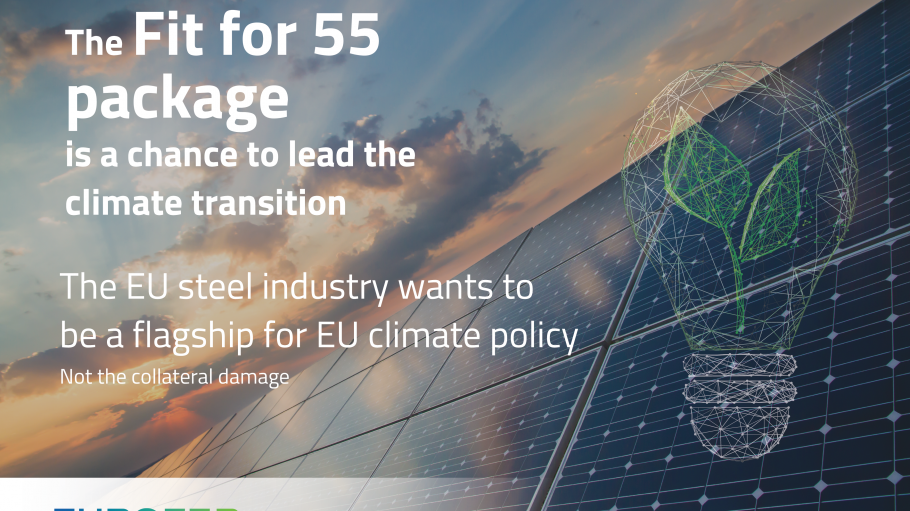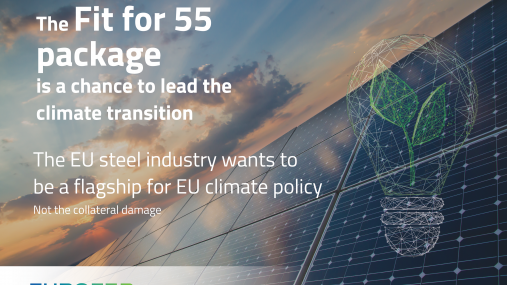
Press releases » A fine balance: Fit for 55 must help decarbonisation of EU steel and prevent carbon leakage effectively
A fine balance: Fit for 55 must help decarbonisation of EU steel and prevent carbon leakage effectively
Downloads and links
Recent updates

Brussels, 15 July 2021 – The Fit for 55 package, released yesterday by the European Commission, needs a more finely balanced approach to enable the decarbonisation of EU steel industry whilst avoiding the leakage of production and CO2 emissions outside the EU.
“This is the decisive decade for the industrial transition. The European steel industry has a clear roadmap showing how it could reduce its CO2 emissions by 55% by 2030 compared to 1990 levels and towards climate neutrality by 2050”, said Axel Eggert, Director General of the European Steel Association (EUROFER). “However, we have always emphasised the cost-effectiveness of climate policy measures, as well as the need to avoid the shifting of investment, production, jobs and CO2 emissions out of the EU to third countries with laxer environmental rules”.
The priority today should be to upscale and deploy low-carbon technologies in industry as fast as possible while remaining internationally competitive. This requires effective carbon leakage measures, markets for green steel, funding support, and affordable low carbon energy.
“European steel companies have more than 100 projects underway that could deliver significant emissions reduction but will require over €50 billion of investment by 2030”, said Mr Eggert. However, components of Fit for 55 would artificially raise carbon costs and reduce the amount of money available to actually cut CO2 emissions”.
From EUROFER’s perspective, the Fit for 55 EU ETS/CBAM proposal to remove financial resources through the post-2026 phase-out of free allocation – in favour of an untested and uncomplete CBAM – risks hindering, rather than incentivising, low-carbon investment.
Instead, the EU steel industry transition towards climate neutrality needs to be accompanied by a comprehensive regulatory framework that supports low-carbon investment while boosting international competitiveness.
"Higher EU climate ambition requires strengthened carbon leakage protection”, emphasised Mr Eggert. “We are committed to cooperating with the European Parliament, Member States and the Commission to making the Package a sustainable growth strategy”.
EU Emissions Trading System (EU ETS)
The proposed EU ETS revision would artificially raise carbon prices by sharply increasing the slope of the linear reduction factor, rebasing the cap and strengthening the Market Stability Reserve. The phasing out – from 2026 – of free allocation would increase industry exposure to the EU ETS costs.
This reduces the amount of money available to invest in low carbon technologies that are supported by other instruments like the Innovation Fund and the revised state aid regime.
Carbon Border Adjustment Mechanism (CBAM)
The CBAM proposal includes no solution for EU export competitiveness, nor any measure to tackle the inevitable circumvention practices (such as absorption of costs or source shuffling) that importers of steel into the EU will engage in.
Renewable Energy Directive (RED)
Similarly, access to competitive low carbon energy - mainly electricity and hydrogen - needs to be supported through incentives rather than the new obligations in the proposed Renewable Energy Directive. Otherwise, the RED will result in higher costs for energy users, even as the wide availability of such resources is still ill-defined at this stage.
Contact
Charles de Lusignan, Spokesperson and Head of Communications, +32 2 738 79 35, (charles@eurofer.eu)
About the European Steel Association (EUROFER)
EUROFER AISBL is located in Brussels and was founded in 1976. It represents the entirety of steel production in the European Union. EUROFER members are steel companies and national steel federations throughout the EU. The major steel companies and national steel federation of Turkey and the United Kingdom are associate members.
The European Steel Association is recorded in the EU transparency register: 93038071152-83.
About the European steel industry
The European steel industry is a world leader in innovation and environmental sustainability. It has a turnover of around €170 billion and directly employs 330,000 highly-skilled people, producing on average 160 million tonnes of steel per year. More than 500 steel production sites across 22 EU Member States provide direct and indirect employment to millions more European citizens. Closely integrated with Europe’s manufacturing and construction industries, steel is the backbone for development, growth and employment in Europe.
Steel is the most versatile industrial material in the world. The thousands of different grades and types of steel developed by the industry make the modern world possible. Steel is 100% recyclable and therefore is a fundamental part of the circular economy. As a basic engineering material, steel is also an essential factor in the development and deployment of innovative, CO2-mitigating technologies, improving resource efficiency and fostering sustainable development in Europe.

Download files or visit links related to this content
Brussels, 02 July 2025 – The 90% climate target proposed today by the European Commission demands an unprecedented transformation of EU society and industry in just 15 years. The European steel industry is already doing its part, but a viable business case for the transition is still lacking. To enable it, the EU needs to implement the Steel and Metals Action Plan much more decisively, delivering a highly effective trade protection against global overcapacity, access to internationally competitive low carbon energy and scrap, and a watertight CBAM, says the European Steel Association.
How global overcapacity is destroying European industries
European Steel in Figures 2025 is EUROFER's statistical handbook, laying out in an easy-to-use format the key statistics and data about the performance and footprint of one of Europe's most important strategic sectors